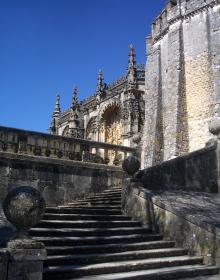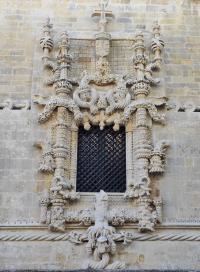- HOME
- MONUMENT
- Convent of Christ
- History
- Architecture
- Personalities
- King Afonso Henriques
- D. Gualdim Pais
- King Dinis
- King John I
- D. Lopo Dias de Sousa
- King Duarte
- Prince D. Henrique (Henry
- King John II (1455 - 1495
- King Manuel I (1469 - 152
- Diogo de Arruda
- João de Castilho
- Jorge Afonso
- Olivier de Gand
- King John III (1502 - 155
- Diogo de Torralva
- Friar Anthony of Lisbon
- Baltazar de Faria
- Filipe Terzi
- Philippine Dinasty
- King Philip II of Spain
- King John IV
- Domingos Serrão
- Queen Mary II
- Prince Fernando
- Costa Cabral
- Artisans and Artists
- Intangible Heritage
- Related Heritage
- Glossary
- VISIT OUR MONUMENT
- HERITAGE LEARNING
- TOMAR
- MONASTERIES ROUTE

History
The Knights Templar came to Portugal in 1128. In 1159, King Afonso Henriques awarded them a vast territory situated halfway between Coimbra and Santarém, known as Termo de Ceras, as a reward for their role in the conquests of Santarém and Lisbon (1147). The Knights Templar founded the Tomar Castle and Village in this region. As a result of the persecution against the Knights Templar by Philip IV of France, the Order was extinct in 1312 by Pope Clement V.
Portuguese King Dinis, however, wishes to keep the Knights Templar and their assets under a new cavalry order, circumscribed to his Kingdom.
This new cavalry order followed the same rules and spirit of the extinct Templar Order.
First Millennium

Since archaeo-historical times, the geography of the region around Tomar has been conducive to human settlement, with the valley and topography emerging as key factors in attracting people to the area. (...)
Click here to find out more
The Knights Templar

Jerusalem is taken by the armies of the Second Crusade to Palestine in 1099. Approximately twenty years later, nine knights from France and Burgundy set up a brotherhood with the intent of protecting the pilgrims throughout the dangerous routes between th (...)
Click here to find out more
The Order of Christ

Pope Clemente V´s Vox Clamantis bull in 1312 decreed the abolishment of the Order of the Temple and all of its assets to be handed in to Hospitallers across all Christian territories. (...)
Click here to find out more
The extinction of religious orders and the Convent of Christ

With the Liberal revolution in 1834 the male religious orders were extinct. However, Queen Maria II keeps the Militia of Christ as an honorary Order, with her as the Master. (...)
Click here to find out more
The Overseas Missions Seminar

Instituted in 1922, it occupied part of the Convent of Christ, mainly the western wing, the Ravens Cloister, the Micha Cloister, the Mess Room, the Kitchens, the Dormitories and the outward vegetable gardens. The purpose of this seminar was to train clerg (...)
Click here to find out more
Regional Military Hospital nº 3

With its closure in 1993, the support for the sick and infirm provided by the Convent of Christ since the 17th century came to an end. (...)
Click here to find out more
SERVICES - ACTIVITIES



